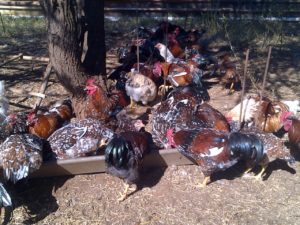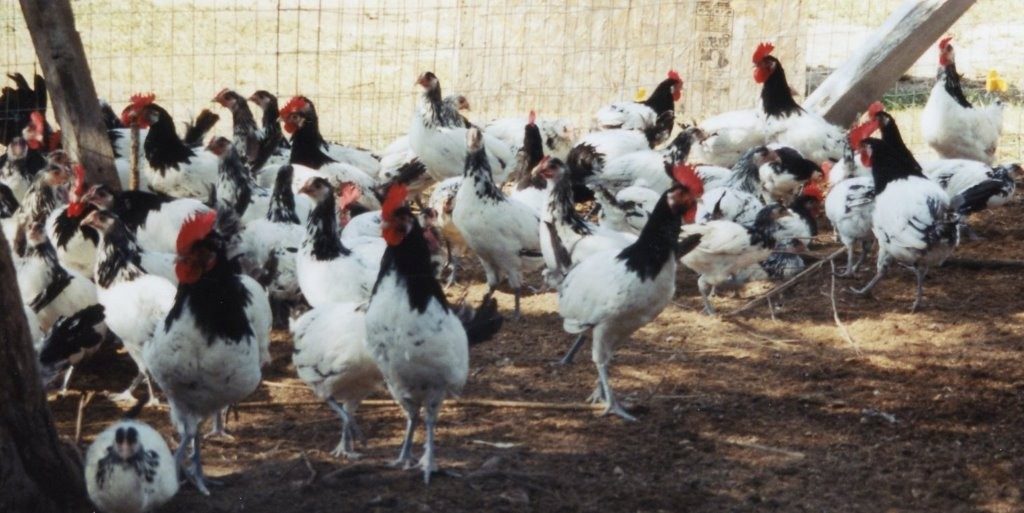
This past summer, I visited the county fair and stopped by the animal barn to look at some of the poultry on display. Specifically, I wanted to see examples of the breeds of chickens available that I may be interested in adding to my flock. Rather than each chicken in their display cage being labeled with a bird’s breed, each cage listed the geographic origin of the chicken within such as Asiatic, Continental or American. This did not benefit my search for potential new members of my flock, but intrigued me enough that I wanted to find out how my flock of 19 hens and pullets would be characterized. Using the classes delineated by the Wisconsin State Fair, my feathered ladies break down to 12 American, 4 English and 3 Continental chickens. There are also classes for Mediterranean and Asiatic (and Other). I live in a part of the United States that gets cold, snowy weather for what seems like six months out of the year, weather that my chickens seem to take in stride. But in other places in the world, heat is the name of the game for the poultry strutting there. In a Genes, Genomics, Genetics publication, Fleming et al. wanted to know if there were genetic differences in Northern European and African chickens that might be caused by their environment.
The lineage of domesticated chickens can be traced from red junglefowl in southeast Asia. But hanging around humans for thousands of years has transformed this animal into the familiar egg-laying feathered fowl we know and love. As a consequence of domestication and accompanying humans in their travels, many chicken breeds can be found worldwide. Researchers decided to look at the genetics of breeds from two very different environments: Northern Europe and Africa. These chickens have lived for numerous generations in their locales and thus would be subject to the local climate conditions. These environmental stresses would likely exert selective pressures on the poultry so Fleming et al. were interested in see what differences might exist. They started by genotyping single nucleotide polymorphisms (SNPs) from 718 individuals of indigenous breeds (375 from Africa and 343 from Europe) encompassing five European countries and nine African countries. After some quality control of the data, only 634 birds had acceptable data dividing into 315 African samples and 319 European samples.
These genotype data were then subjected to various software analyses. Analyzing the data by temperature profiles and genotype showed that the Northern European chickens clustered together both by country and continent, and the same held true for the African chickens. Taking both genotype data sets and looking for regions of increasing genomic differentiation, chromosomes 4, 17 and 27 showed peaks during analysis. Examining the gene ontology of the region of chromosome 4, which showed higher allele frequency in the Northern European chickens, included functions related to developmental pathways and immune response. The chromosome 17 region had genes involved with calcium sequestration and blood vessel creation. For chromosome 27, the possible region under selection included genes for feather keratin and nearby a recently discovered quantitative trait locus (QTL) for body temperature under heat stress conditions.

Examining the single nucleotide variants (SNVs), researchers sought indications of selection in the SNP genotypes. In the African population, there were three chromosomes that generated the top three scores: Chromosomes 25, 26 and 27. The highest scoring SNVs in chromosome 25 were in or near feather and claw keratin genes, while chromosome 27 SNVs occurred near heat stress genes. The Northern European population had significant selection values in chromosomes 2, 3 and 20, but were of less statistical significant SNVs compared to the scores for the African population. Another analysis using pairwise comparison of the genotypes of Northern European and African chickens found the highest variant values on chromosomes 2 and 27, with chromosome 2 having the largest number of statistically significant SNVs.
Using these various computed selection signatures, Fleming et al. analyzed the downstream gene ontology from the genes found near the significant SNVs in the various chromosomes. For the chickens indigenous to Africa, apoptosis, immune function and homeostasis processes were altered significantly whereas chickens indigenous to Northern Europe had changes in pathways involved in cell adhesion and angiogenesis.
Additional analysis on gene diversity and environmental factors (precipitation and temperature) on the two chicken populations found selective associations with both factors. Some of these loci under pressure also overlapped with those that were significant in selection signatures analyses including chromosomes 25, 26 and 27 for African chickens and chromosomes 2, 3 and 20 for Northern European chickens.
What have Fleming et al. discovered with their analysis of African and Northern European chickens? Their results indicate that there are different regions of the chicken genome under selection and that those areas of diversity are affected by the climate in which the breed of poultry has existed. African chickens seem to have strong selection markers on chromosome 27, suggesting mechanisms that allow the birds to tolerate heat from homeostatic functioning to angiogenesis. Northern European chickens showed selection in loci on chromosomes 2 and 3 that affect metabolism and feathering, two processes that can affect how the animal keeps warm in the colder climate. Not only will I look at my flock with new appreciation for their adaptations but know it is appropriate that that most of my chickens are classified as American Large Fowl breeds, ones likely adapted for the environmental conditions in my locale.
Reference
Fleming, D.S., Weigend, S., Simianer, H., Weigend, A., Rothschild, M., Schmidt, C., Ashwell, C., Persia, M., Reecy, J. and Lamont, S.J. (2017) Genomic comparison of indigenous African and Northern European chickens reveals putative mechanisms of stress tolerance related to environmental selection pressure. G3 (Bethesda) 7, 1525–37. doi: 10.1534/g3.117.041228.
Post updated April 12, 2024 to remove broken link.
Sara Klink
Latest posts by Sara Klink (see all)
- A One-Two Punch to Knock Out HIV - September 28, 2021
- Toxicity Studies in Organoid Models: Developing an Alternative to Animal Testing - June 10, 2021
- Herd Immunity: What the Flock Are You Talking About? - May 10, 2021
